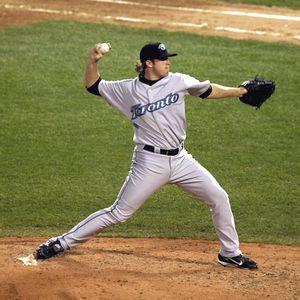
Baseball, once the simple and lyrical pastime responsible for lots of bad poetry and purple newspaper prose, is a complicated game in the 21st century. Fans like us are constantly at odds with what we see and think we know and what later proves true. The Blue Jays second baseman &mdash who wears number 2 &mdash is a walking example of this troubling dichotomy.
On the surface, Aaron Hill is awesome. Aaron Hill hits for power, plays hard, gets dirty, plays a fine second base and seems like an all-around affable dude. He rose through the system and excelled at the big league level; signing away his arbitration years and putting up huge numbers in his first healthy season back in the fold. On the surface, Aaron Hill is a no-brainer.
But, on the nuts and bolts side, trouble brews. Many advanced baseball watchers question his ability to get on base, his ability to maintain a somewhat astronomical home run rate. This was a main point of discussion when two bloggers met in this country's capital city. Over a few dozen pints of bitter, we (he and I, not his version of we) debated the anger of the stats community. So quick to discard a season like Hill's 2009 and so quick to point out the shortcomings in his game. Why isn't it enough that Aaron Hill fields like a demon, hits the ball (consistently) hard, and puts up pretty counting stats? We can't fans like us appreciate Hill for what he is, not what he lacks?
While the statty side of the game may seem cold and indifferent, there are legitimate concerns to address in Aaron Hill's game. An excellent piece on Baseball Analysts this week highlights one of his offense's shortcomings. Aaron Hill's strikeout rate combined with his low walk rate put him into some slightly scary company. How scary? Jeff Francoeur has nearly the identical profile. Walk rate at or below 5.5% (of PAs) with a strikeout rate close to 15%. I'm not going to lie to you - that ain't good. Guys like Francoeur don't make it too difficult to get them out, hopefully Aaron Hill and his frozen roping ways don't follow the same career path.
Another post, this one on Beyond the Box Score, increased my level of dread for Aaron Hill in the future. The BtB Brains created clusters based on batted ball profiles and examined the average wOBA of those in the cluster. Imagine my shock when I discovered Aaron Hill lands in the fringes cluster 7 (high line drive, high home run, high walk). The average wOBA in that section: .398. Hill's weighted on base average: .357. His walk rate is half of the rest of the guys around him. Does that bode well or portend doom? Shouldn't I be excited for Hill to land in such exclusive company?
It comes down to raw, naked belief. Do I believe Aaron Hill's walks will rise to match his other components, or will the ever-important batted ball numbers fall to match his paltry walk totals? Did we see the best season of Hill's career in 2009 or the first, gigantic steps towards his ascent to the truly elite of the game?
The chicken and egg scenario above may not move us to jersey purchases and franchise cornerstone titles, but it lends itself to bigger issues. Do we put too much emphasis on capital V Value and not enough on the kind of return on investment an exciting player like Hill delivers?
One thing is for sure: walk rates be damned, Aaron Hill is officially the Best Blue Jay and certainly the number one reason to watch this club in 2010. None of the questions raised here are worth lobbing toward anyone else on the roster. Hoping for Aaron Hill to make one more leap into the Outer Chutlosphere of 6/7 Win dudes is one thing, enjoying the barrel-chested greatness of his line drive barrage is another. Here's hoping they stay out of each other's way.
Reuters image courtesy of Daylife.

























